- Village of Hogsmeade Guide - August 11, 2023
- Harry Potter Howler Guide - August 3, 2023
- Biggest Plotholes in the Harry Potter Universe - July 26, 2023
If there’s one thing that Harry Potter is famous for, it’s magic. The series is full of spells, potions, magical creatures, and more. The excitement of these enchantments is undeniably a factor in drawing in fans from all over the world. Even though Harry and his friends are compelling characters, the franchise simply wouldn’t have had as much impact if it wasn’t set against the backdrop of magic. This article will be a complete Harry Potter magic lore guide.
But what exactly is magic? How does it work? What’s the history of it? As a writer, I know how much fun worldbuilding can be, and it’s clear that J.K. Rowling also enjoys that element of creating complex backstories for the world of Harry Potter. There are many rules for the way spells and the like works, whereas other components are left frustratingly vague. There are also a few seemingly contradictory uses of magic throughout the series. Still, those are best ignored as you won’t find a satisfactory resolution. You don’t want to let it ruin your enjoyment of Harry Potter.
We’ll explore the limitations of using magic, the different uses and abilities that it can bring, the places where it can be learned, the way it’s regulated, important historical events, and more. You’ll have a complete understanding of how magic is involved in the series by the end.
Who Can Use Magic?
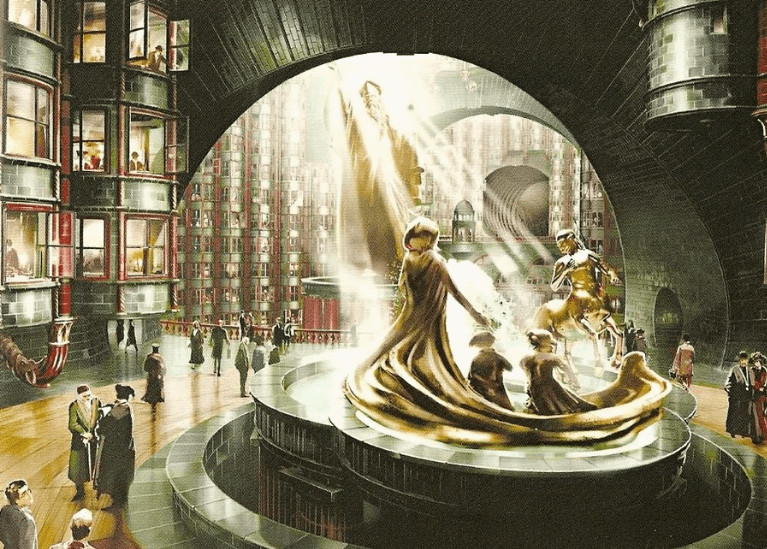
Magic is a broad term that can be applied to several different phenomena in the Harry Potter universe, and that will be explored in more detail throughout this guide. But only certain kinds of people are able to wield these magical abilities, namely, witches and wizards. Witches and wizards fall under three categories – pure-blood (two magical parents), half-blood (one magical parent and one muggle parent), and muggle-born (two muggle parents). And just like two muggles can have a magical child, there are cases where two magical parents can have a non-magical child. These children are known as squibs, and one example of a character who’s a squib is Argus Filch, the caretaker at Hogwarts.
Only witches and wizards are able to brew potions or cast spells. If a muggle followed a recipe for a potion, it would not work, as there’s magic required for the effects to take place. However, there are also magical items in the wizarding world, and these can technically be used by a muggle or a squib. For this to work, they would have to be assisted by a witch or wizard, so they couldn’t operate the magical item by themselves. But a muggle would be able to do something magical such as ride a broom, as long as they were accompanied by someone magical.
What Types of Magic are There?
We see multiple types of magic used throughout the series, each falling under different categories. You probably just think of using a wand to cast a spell when you think of magic. Still, in reality (according to the lore of the series, not our reality), there’s a lot more to it than that. Let’s take a look at the different types of magic present in Harry Potter’s world.
Spells
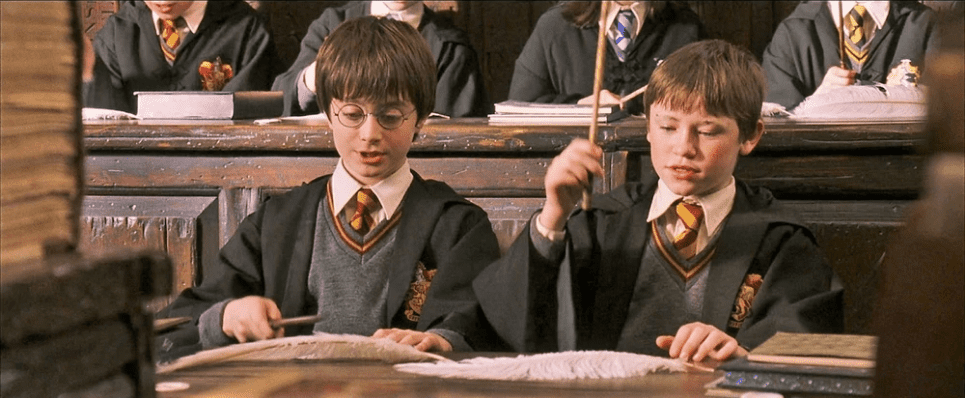
There are multiple types of spells, which fall under several different categories. Still, to keep this section relatively succinct, I will list most spells together and only separate curses/ hexes. For each spell, I’ll give the incantation and a brief summary of what the spell achieves (if known). I’m only including spells with a known incantation. I’m also not including spells which are found only in the Harry Potter video games or the Fantastic Beasts and Where to Find Them movies, as they sometimes contradict the magical lore of the main series.
- Aberto. Opens doors.
- Accio. Summons objects to you.
- Aguamenti. Produces clean drinking water.
- Alarte Ascendere. Shoots the object/ being into the air.
- Alohomora. Unlocks things.
- Anapneo. Clears a blocked airway.
- Anteoculatia. Makes someone/ something grow antlers
- Aparecium. Reveals hidden messages/ markings.
- Appare Vestigium. Reveals traces of magic.
- Aqua Eructo. Like aguamenti, but more forceful. Used to put out fires.
- Arania Exumai. Defends against spiders/ acromantulas.
- Arresto Momentum. Slows down the momentum of a falling object/ being.
- Ascendio. Lifts you into the air.
- Avifors. Turns something into a bird.
- Avis. Conjures birds out of thin air.
- Baubillius. Effects unknown.
- Bombarda. Produces an explosion.
- Bombarda Maxima. Produces a bigger explosion.
- Brackium Emendo. Supposedly mends broken bones, but when misused, can remove them altogether.
- Cantis. Makes someone start singing uncontrollably.
- Capacious Extremis. Makes something bigger on this inside. (Is this how the TARDIS works…?)
- Carpe Retractum. A rope of light that pulls things towards you or pulls you towards things.
- Cave Inimicum. Hides you from others.
- Cistem Aperio. Opens boxes.
- Colloportus. Locks things.
- Collovaria. Changes something’s color.
- Confundus. Confuses someone.
- Crinus Muto. Changes your hair color/ style.
- Defodio. Digs/ carves into something.
- Deletrius. Counter to the Prior Incantato.
- Deprimo. Blasts a hole in the floor.
- Depulso. Pushes someone/ something away.
- Descendo. Makes something fall down.
- Diffindo. Neatly cuts things.
- Diminuendo. Shrinks something.
- Dissendium. Opens passageways.
- Draconifors. Turns something into a dragon.
- Ducklifors. Turns something into a duck.
- Duro. Turns something into stone.
- Ebublio. Traps someone in a bubble.
- Engorgio. Makes something bigger.
- Episkey. Heals minor wounds/ breakages.
- Epoximise. Sticks things together.
- Erecto. Builds a tent/ structure.
- Evanesco. Makes something disappear.
- Everte Statum. Throws someone backwards.
- Expecto Patronum. Produces a patronus.
- Expelliarmus. Disarms someone.
- Expolso. Produces an explosion.
- Ferula. Bandages up wounds.
- Fianto Duri. Strengthens magical shields.
- Finestra. Breaks glass.
- Finite Incantatem. Ends the effects of spells.
- Flagrate. Writes in mid-air.
- Flintifors. Turns things into matchboxes.
- Fumos. Produces a smokescreen.
- Geminio. Duplicates objects.
- Glissio. Causes stairs to flatten.
- Herbifors. Makes plants grow out of someone.
- Herbivicus. Makes plants grow.
- Homenum Revelio. Shows if anyone is nearby.
- Illegibilus. Makes writing impossible to read.
- Immobulus. Freezes things in place.
- Impedimenta. Stops oncoming beings/ objects.
- Impervius. Makes something repel water.
- Incarcerous. Ties someone/ something up with ropes.
- Incendio. Makes fire.
- Lacarnum Inflamari. Sets a cloak on fire.
- Lapifors. Turns something into a rabbit.
- Legilimens. Allows you to read someone’s mind.
- Liberacorpus. Reverses Levicorpus.
- Locomotor. Lets you move an object.
- Lumos. Produces light.
- Lumos Maxima. Produces more light.
- Lumos Solem. Produces sunlight.
- Mobiliarbus. Moves wooden objects.
- Mobilicorpus. Moves people’s bodies.
- Molliare. Creates an invisible cushion.
- Morsmordre. Creates the Dark Mark.
- Muffliato. Causes others to hear a hum that drowns out speech.
- Mutatio Skullus. Makes someone grow extra heads.
- Nox. The counter to Lumos.
- Nebulus. Makes fog appear.
- Obliviate. Wipes someone’s memory.
- Obscuro. Stops someone being able to see.
- Orchideous. Makes flowers appear.
- Partis Temporus. Creates a split in something.
- Periculum. Shoots red sparks.
- Piertotum Locomotor. Animates objects.
- Piscifors. Turns something into a fish.
- Portus. Creates a Portkey.
- Prior Incantato. Reveals the last spell a wand used.
- Protego. Creates a magical shield.
- Quietus. Makes someone/ something quieter.
- Reducio. Makes something smaller.
- Reducto. Breaks something.
- Reverte. Returns something to its original state.
- Rennervate. The counter to Stupefy.
- Reparo. Fixes something that’s broken.
- Revelio. Shows someone’s/ something’s secrets.
- Rictusempra. Tickles someone to weaken them.
- Riddikulus. Defends against a Boggart.
- Salvio Hexia. A shield against hexes.
- Scourgify. Makes something clean.
- Serpensortia. Summons a snake.
- Silencio. Stops something making noise.
- Sonorus. Makes something louder.
- Stupefy. Stuns someone.
- Tarantallegra. Forces someone’s legs to dance.
- Tergeo. Cleans things, especially to remove liquid.
- Verdillious. Shoots green sparks.
- Vulnera Sanentur. Heals wounds and slows bleeding.
- Waddiwasi. Shoots small wads such as chewing gum.
- Wingardium Leviosa. Makes something levitate.
Curses, Hexes, and Jinxes
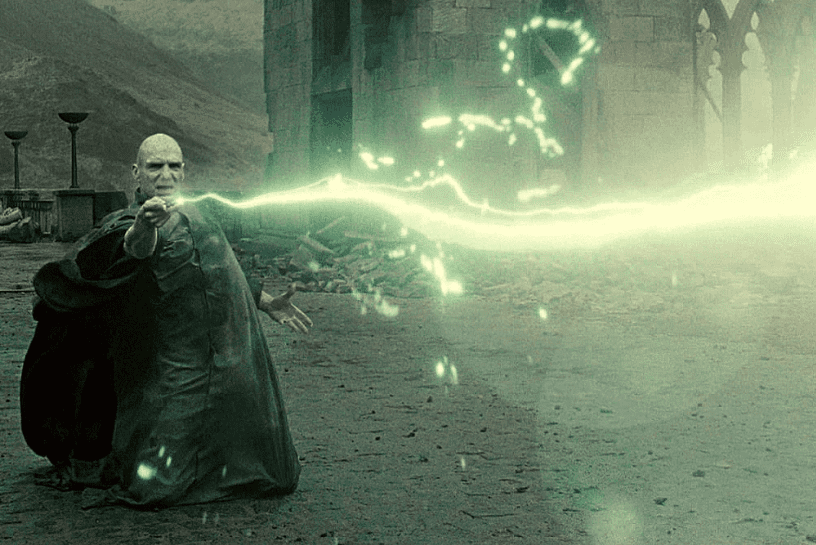
- Avada Kedavra. Kills someone/ something.
- Calvorio. Gets rid of someone’s hair.
- Colloshoo. Roots someone’s shoes to the ground.
- Confringo. Produces an explosion of fire.
- Crucio. Causes someone excruciating pain.
- Densaugeo. Makes someone’s teeth grow.
- Entomorphis. Turns someone into an insect.
- Furnunculus. Covers someone in boils and pimples.
- Imperio. Makes someone obey you.
- Inflatus. Inflates something/ someone.
- Langlock. Glues someone’s tongue to the roof of their mouth.
- Locomotor Wibbly. Makes someone’s legs weak like jelly.
- Levicorpus. Lifts someone into the air by their feet.
- Locomotor Mortis. Locks someone’s legs together.
- Melofors. Traps a person’s head in a pumpkin.
- Mimblewimble. Knots a person’s tongue so they can’t speak.
- Oppugno. Makes objects/ beings attack someone.
- Petrificus Totalus. Freezes a person’s entire body.
- Relashio. Makes someone let go of what they’re holding.
- Sectumsempra. Slashes someone, creating deep wounds.
- Tittilando. Tickles someone uncomfortably.
Potions
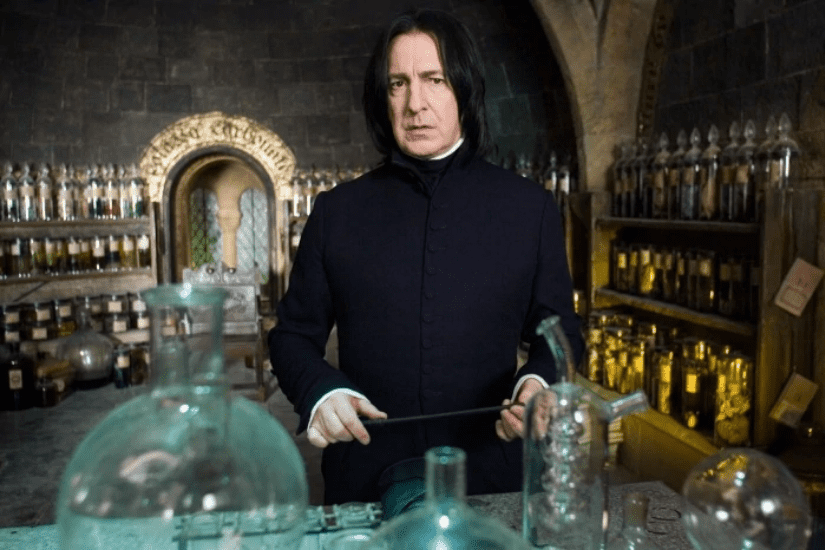
As well as casting spells, witches and wizards can also brew potions to create a specific effect. There are many potions referenced throughout the series, each with a unique quality to it. I won’t list all of them as it wouldn’t be as concise as the spells list, but I’ll give some examples of potions that had significance throughout the Harry Potter books and films. Potions are brewed in a cauldron following an exact recipe of ingredients. Much like it’s dangerous to mispronounce a spell, perfectly failing to follow a potion recipe can lead to disastrous consequences.
When you think of potions in Harry Potter, I expect the first one that comes to mind is Polyjuice Potion. Harry, Ron, and Hermione brew this in their second year, leading to some hilarious scenes. This potion allows the drinker to temporarily transform into someone else’s physical body, provided they add the special ingredient of part of the intended person (usually something innocuous like a hair). This potion is used again in Harry Potter and the Goblet of Fire when Barty Crouch Jr uses it all year to pretend to be Mad-Eye Moody so he can get close to Harry.
Veritaserum is also known as a truth potion, and appears in Harry Potter and the Order of the Phoenix when it’s used by Dolores Umbridge on several students, trying to find out details of a secret student society. The one she’s looking for is Dumbledore’s Army, which Harry set up to train students in Defence Against the Dark Arts, seeing as Umbridge was refusing to let them use magic in class.
Possibly the most exciting potion is Felix Felicis, as it tampers with the very fabric of reality. Drinking this potion makes the user extra lucky, and everything they attempt will be successful for them. The way this potion works is not fully understood. Rather than affecting the user directly, it instead affects their circumstances, which suggests the potion is somehow omnipotent. The potion is complicated to brew correctly and is therefore really rare. Harry obtains some as a prize in Harry Potter and the Half-Blood Prince. He uses it to convince Professor Slughorn to share an essential memory regarding Tom Riddle, aka Voldemort.
Magical Items
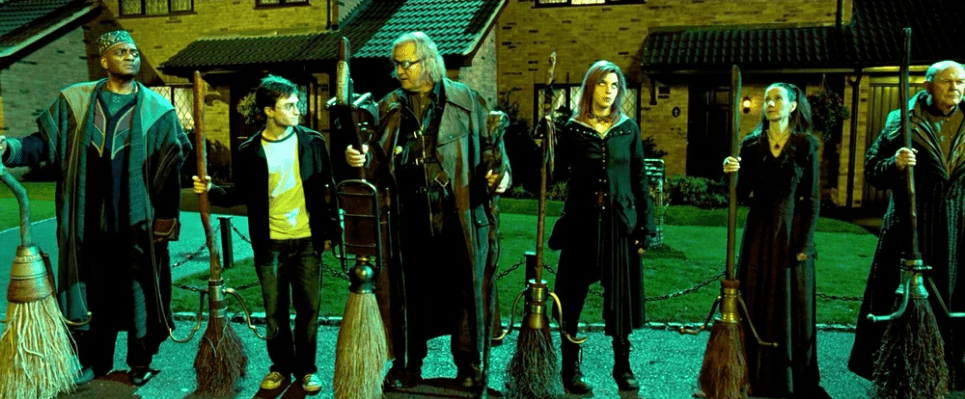
Witches and wizards can also continue to enjoy the effects of magic without having to actively cast a spell or brew a potion. Several magical objects appear throughout Harry Potter, and witches and wizards use these as part of their daily life. They are ingrained in wizarding culture and serve many vital purposes. As with the potions, it would take up too much space to try to list every single one, so again, I will focus on a few interesting examples.
The first one that comes to mind is the magical flying broomsticks they use. This plays into the popular real-world stereotype of witches flying around on broomsticks. Still, J.K. Rowling made it her own in Harry Potter. There are specific models of broomsticks that have been expertly crafter to fly on. Different brands have varying qualities, and some are faster and more responsive than others, such as the Firebolt that Harry acquires in Harry Potter and the Prisoner of Azkaban. Brooms are commonly used to play Quidditch, as they’re not really supposed to fly around on them as a means of transport in case they’re seen by muggles.
Magic is also used to bring photos to life. The walls of Hogwarts are adorned with moving portraits, where the painted beings inside seem to have genuine life and will interact with each other and with humans who pass them. Moving portraits are also found in wizarding newspapers such as The Daily Prophet or The Quibbler. Some of these portraits are connected to each other, such as the portrait of Phineas Nigellus Black, where he can freely move between his frame in 12 Grimmauld Place and his frame in Dumbledore’s office.
Portkeys are a magical object that allow people to travel between two pre-determined places. Whereas with apparition, you can choose where you want to go, with a portkey, you have to program the location when you first bewitch it. Portkeys are usually created out of boring or undesirable objects such as an old boot or an empty can to reduce the risk of a muggle touching it. Portkeys are used to transport to get to the Quidditch World Cup in Harry Potter and the Goblet of Fire. It means that the underage witches and wizards can easily travel there, as they cannot apparate.
Innate Magic
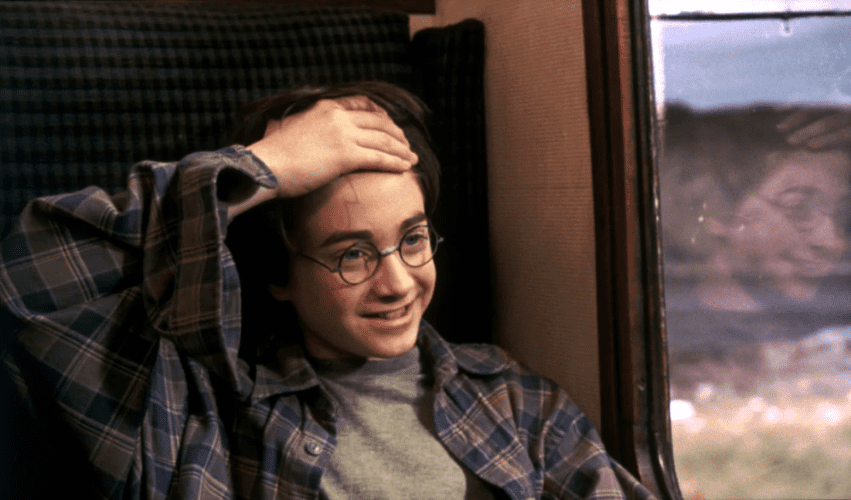
Although witches and wizards typically use wands to focus their magical power, it is possible to use magic that simply comes from inside themselves. However, this kind of innate magic is often random and uncontrolled. Most commonly, it’s seen in children as they approach their eleventh birthday, and it’s why their magical teaching doesn’t start until that age, as it allows their innate abilities to manifest first.
In Harry, we see this through several peculiar events. He has difficulty at his primary school (before he attends Hogwarts) and is often the target for bullies. One time, he’s running away from them and finds himself suddenly on the roof the school with no idea how he got there. Clearly, his magic kicked in to rescue him, transporting him to the roof without him ever actually intending it. Another time, he’s at the zoo with his family, and his cousin Dudley pushes him out the way. In anger, Harry accidentally causes the glass to disappear, freeing the snake behind it and making Dudley fall inside the enclosure.
One recurring example of innate magic throughout the series is Harry’s scar. It was created when Voldemort tried to kill Harry as a baby, marking extreme dark magic. The scar plays a frequent part throughout the series, not just in people recognizing Harry, but it has its uses. It twinges whenever danger is nearby, such as when Harry sees Professor Quirrell in Harry Potter and the Sorcerer’s Stone because Voldemort is secretly attached to the back of Harry’s head.
We also have other powerful types of innate magic, such as love. It’s revealed that Harry survived Voldemort’s murder attempt because of the powerful magic that was Lily’s love for Harry. She sacrificed herself for him and, in doing so, imbued Harry with protection. She didn’t cast a spell; it was her innate love for him that produced the magical protection.
Other Types of Magic
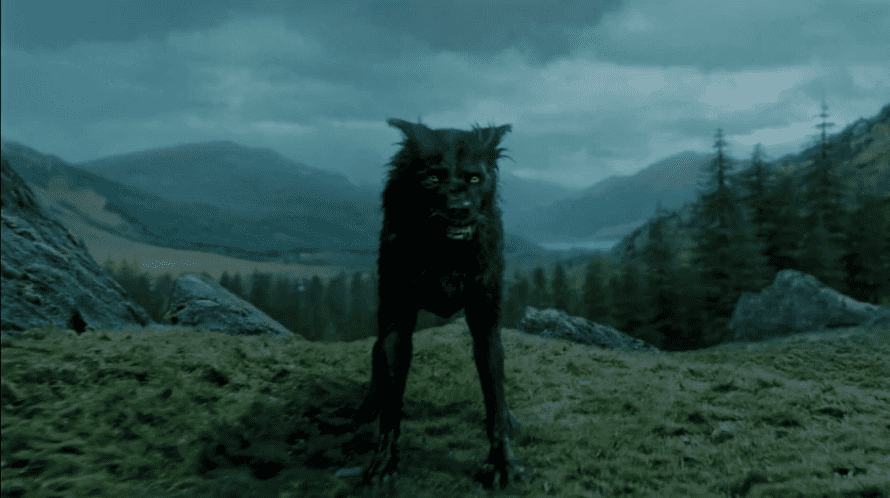
Not all types of magic fit neatly into the categories above, and I wanted to address a few of the more critical outliers. One exciting magical skill that does not involve a wand is apparition. This is a fancy way of saying teleportation. It allows witches and wizards to transport themselves magically directly from one place to another. It’s a complex skill that students aren’t taught until their 6th year of Hogwarts. They have specific lessons in the Great Hall, and it takes several weeks to master them and can be dangerous when it goes wrong. If a person apparates improperly, it can result in splinching. One part of the body gets separated and left behind.
Another fun bit of magic is the idea of an animagus. These are witches and wizards who can turn into an animal at will. There’s a complex ritual that goes into becoming one, and it’s why so few people decide to do it. There are a handful on known animagi in the series, and these are:
- Professor McGonagall. Cat.
- James Potter. Stag.
- Sirius Black. Dog.
- Peter Pettigrew. Rat.
- Rita Skeeter. Beetle.
There are also some witches or wizards who are what’s known as a metamorphagus. It allows them to change their hair and facial features at will. This is an ability that they’re born with and cannot be learned. However, other witches and wizards can still learn spells to allow them to do similar. It’s a very rare trait, which not many people possess, but we know that Nymphadora Tonks was a metamorphagus. She also passed it on to her son Teddy Lupin, who we see in the chapter Nineteen Years Later in the book of Harry Potter and the Deathly Hallows.
Where Can Magic be Learned?
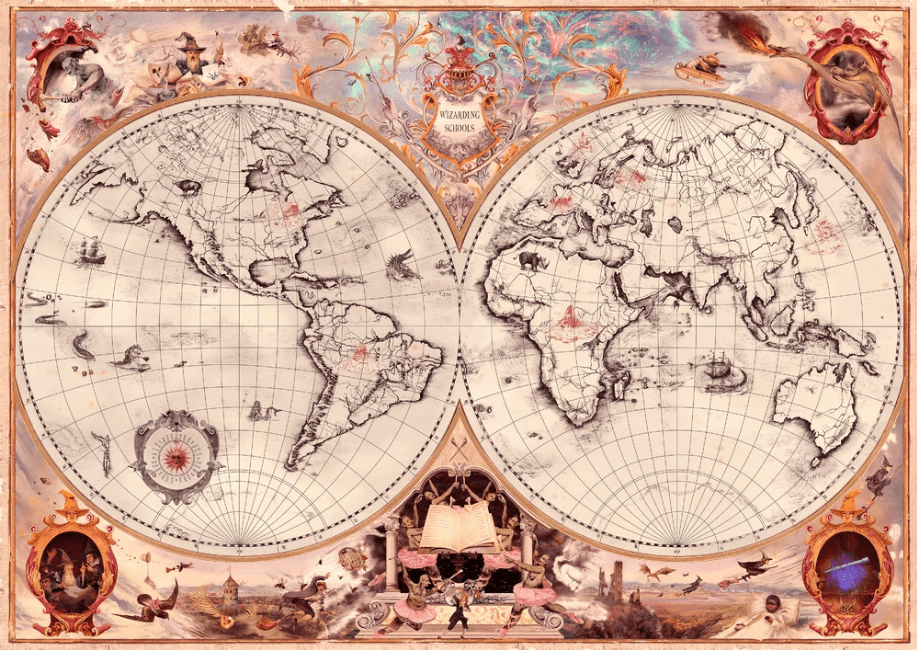
So, although children do start developing magical skills without any formal training, they need to learn how to control their magical abilities and focus them. Obviously, this isn’t the type of thing that can be learned at a regular muggle school, and so there are several wizarding schools throughout the world.
One thing that strikes me as weird is the uneven distribution of these schools. For example, there are 3 known wizarding schools in Europe, but only one for the entirety of America? Also, if you live in a country without its own wizarding school, how do you choose where to go? Do all the schools in your continent contact you? Do you have to decide between them and contact them yourselves? If there’s a Muggle-born student, do they just not get to go as the parents aren’t aware of the different schooling options?
Questions aside, there’s still plenty that we know about the various schools, so let’s explore them.
Hogwarts
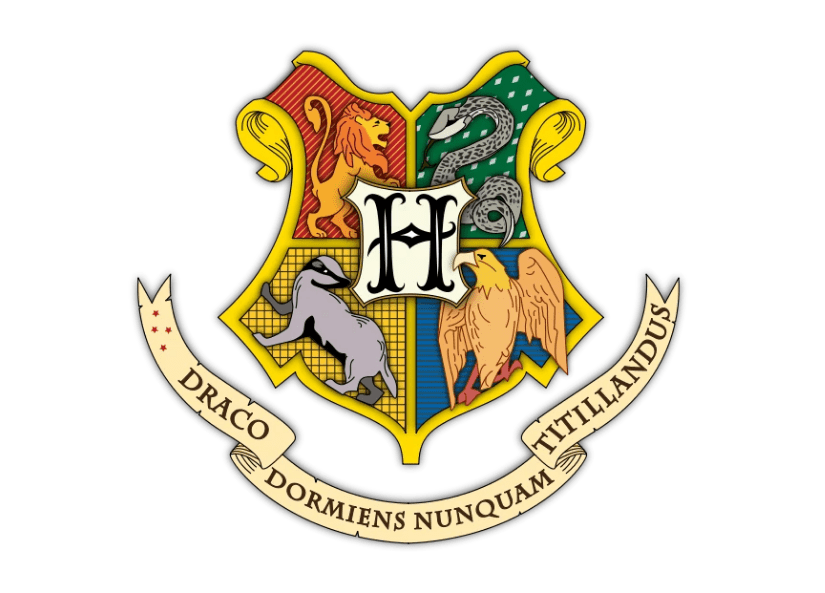
Hogwarts School of Witchcraft and Wizardry is the main setting for the Harry Potter series and so is the most well-known of all the schools. Based in the Scottish Highlands, it services all the students in the UK. Although it’s not technically obligatory, the most common way of getting to Hogwarts is to take the Hogwarts Express from Platform 9 3/4 at King’s Cross station in London. However, if students lived near Hogwarts anyway, they could take other means of transport, provided that they were of a magical nature, such as the Knight Bus.
Hogwarts has 4 houses – Gryffindor (for the brave), Slytherin (for the ambitious/ resourceful), Ravenclaw (for the intelligent/ creative), and Hufflepuff (for the loyal). The houses are named after the four founders of Hogwarts, and each showcases the desired traits of their founder. The students are sorted by means of the Sorting Hat. This enchanted hat sees deep into that person’s heart and determines their qualities. This happens on their first day of arriving at Hogwarts during what’s known as the Sorting ceremony.
Hogwarts has many incredible features, such as secret passageways, moving staircases, and the Room of Requirement. There are also several ghosts that roam the halls, and moving paintings adorn most hallways. There are also large outdoor grounds where the children can explore or go to lessons. Along the edge of the grounds is the Forbidden Forest, home to many dangers. The students aren’t allowed to go inside it. Like the other European schools, Hogwarts is unplottable, meaning it doesn’t appear on maps and people can’t just apparate inside.
European Wizarding Schools
In Harry Potter and the Goblet of Fire, we’re introduced to the two other European wizarding schools. They all take part in the Triwizard Tournament. There’s Beauxbatons, which is based in France, and Durmstrang, which is in Scandinavia. Although we know that Viktor Krum is a student there and that he’s Bulgarian, the actual school is supposedly in either Norway or Sweden.
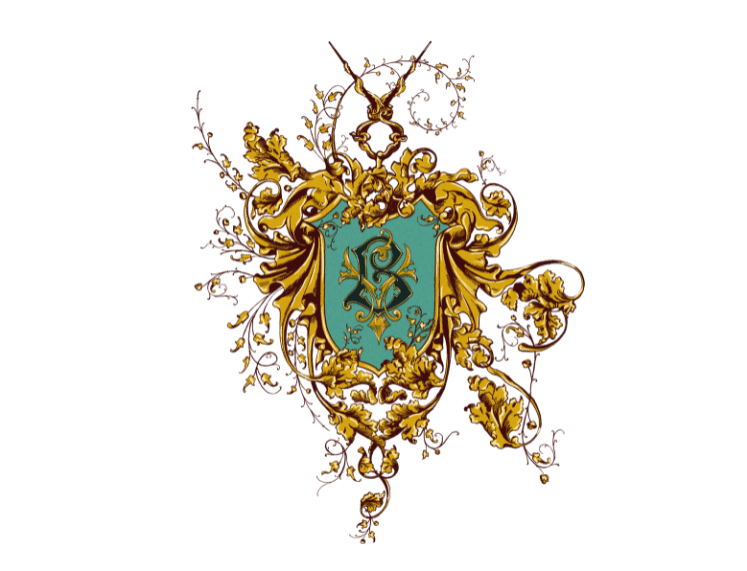
Beauxbatons is led by Olympe Maxime, who Rubeus Hagrid takes a fancy to. The school is over 700 years old and has a rich history of teaching students. It’s described as being much fancier than Hogwarts or Durmstrang; for starters, it’s a palace rather than a castle. They have choirs of wood nymphs that sing to them whilst they’re eating their meals. Even the carriage that the students arrive in for the Triwizard Tournament is a beautiful gilded gold and blue, which matches the students’ uniforms. There’s a high focus on excellence, and the regime seems much more formal than Hogwarts. They also take their OWLs in year 6, which gives them an extra year to study.
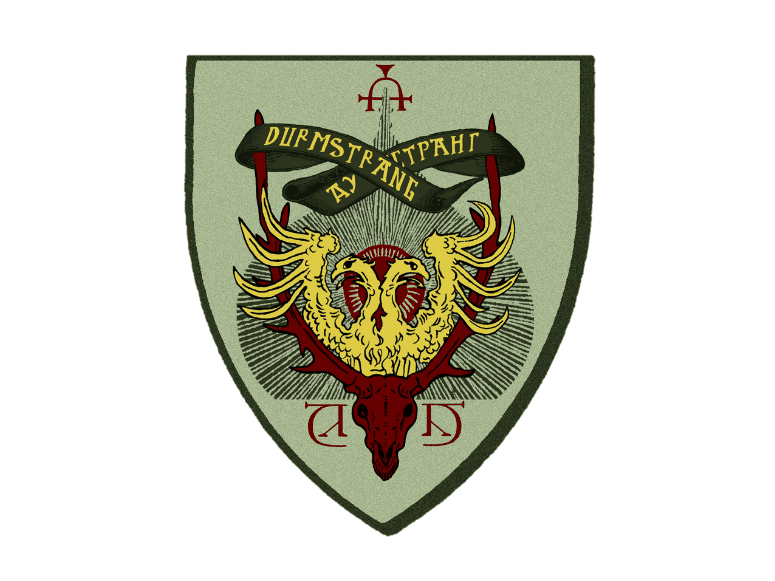
Durmstrang is more similar to Hogwarts in looks, as it’s also set in a castle, but the building is a bit smaller as it’s only 4 stories high. They do have extensive grounds, though, so their students have plenty of space to move around and explore. As the weather is quite cold in Northern Europe, their uniform includes thick red fur cloaks and hats, presumably to keep the students warm. They do have a very discriminatory school policy in that they don’t allow Muggle-borns to attend. The school is led by Igor Karkaroff, who used to be a Death Eater, so that could explain why he’s so anti-Muggle.
Ilvermorny
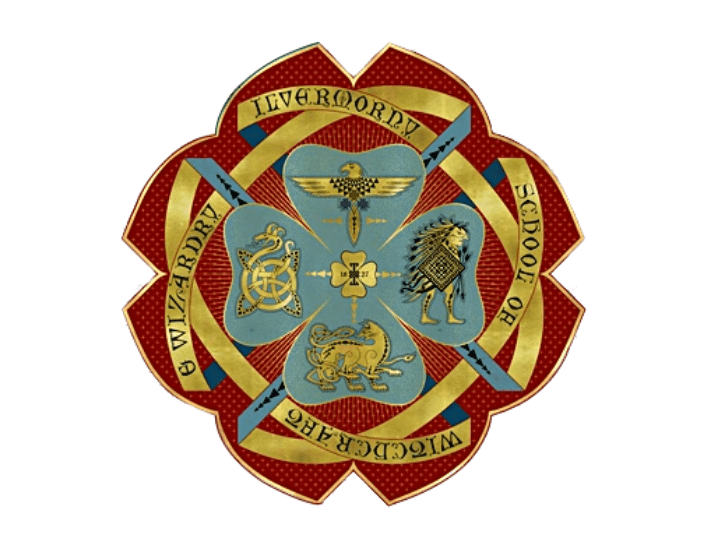
This school never appeared in the Harry Potter books or movies but is instead part of the extended lore. It would also have relevance to Fantastic Beasts and Where to Find Them, as most of the witches and wizards in that franchise would have been taught at Ilvermorny. The school is based in Massachusetts and welcomes students from all across North America, including countries outside the USA, such as Canada and Mexico. The building itself is a large castle, although originally it was a simple family home. It kept being expanded upon over time until it became a castle.
Just like Hogwarts, Ilvermorny has 4 houses. These are:
- The Horned Serpent – This house favours traits such as wisdom and intelligence, and its members tend to be great scholars.
- Wampus – This house is all about strength and bravery, much like Gryffindor, and its members have a warrior’s spirit.
- Thunderbird – No, not like the children’s TV show or the Busted song. It’s actually named after the magical beast which flies and creates storms as it does so. This house puts an emphasis on adventurous attitudes.
- Pukwudgie – This is a more gentle house, and its members often become healers or similar. Pukwudgie supposedly represents the heart of a witch or wizard.
The Ilvermorny sorting ceremony is really interesting. Their entrance hall has 4 wooden statues, one representing each of the houses using the magical beasts they’re named after. The new students stand on a knot in the floor in front of these carvings, and whichever house they belong to will be revealed through the statue reacting. However, whilst the Sorting Hat at Hogwarts makes the choice for the student, that’s not always the case at Ilvermorny. Sometimes a student will be wanted by more than one of the statues. In that situation, the students themselves choose which house they want to be part of. Students at Ilvermorny also have a wand ceremony rather than buying it beforehand, so they get their wand from the school itself.
Other Wizarding Schools
Aside from the previously mentioned schools, there are a few more confirmed schools that J.K. Rowling has revealed the existence of. We don’t have many details on these beyond their locations, but perhaps in the future, we’ll learn more through sites like Pottermore. Here are all the other known schools:
- Mahoutokoro – This is the Japanese school.
- Uagadou – Based in Uganda, other African students are presumably also able to attend.
- Koldovstoretz – It’s known to be the Russian school, but the exact location is unknown.
- Castelobruxo – Based in Brazil, it presumably services the South American students, just like Ilvermorny is open to all of North America.
- Unnamed Australian School – Whilst it has been revealed that there is a school in Australia, its name is still a mystery.
- Two more unkown schools – We know that there are 11 schools in total, but the details of the last two have been kept under wraps. If I had to guess, I’d imagine they’d be based in India and China, as geographically, that would make the most sense.
How Can Spells be Cast?
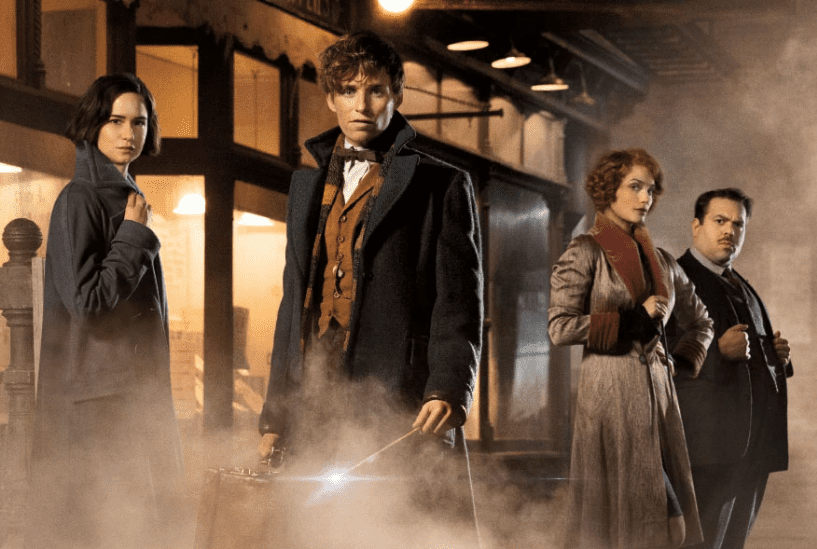
So, we’ve covered what magic is and where it can be learned, but if someone wanted to cast a spell, how exactly would they go about it? Whilst wandless magic does exist, it’s often unintentional and is unfocused. The purpose of a wand is to direct the magical ability of a witch or wizard, and it’s essential part of the spell-casting process. We see how much trouble Ron Weasley has with magic in Harry Potter and the Chamber of Secrets when his wand is defective.
When it comes to casting spells, there are two broad methods – verbal spells and non-verbal spells. Let’s go over the specifics of both of them!
Verbal Spells
This is the most common way of casting spells and requires the least effort on the behalf of the witch or wizard. Every spell will have a specific incantation, which produces the desired effect when said aloud. Students will be taught the words that they need to say and the accompanying wand movement. It’s essential to pronounce the words exactly as they’re supposed to be said. Any slight deviation can lead to potentially catastrophic consequences.
Non-Verbal Spells
These are taught to Hogwarts students in their 6th year. They are renowned for being incredibly difficult to perform, requiring a lot of mental strain from the user. They need the same incantation as a regular spell; however, instead of being said aloud, the words are merely thought of instead. The benefit of these is that it means an opponent in a duel would have no advanced warning of what spell you were casting and when you were casting it. It gives you a split-second advantage that could be vital.
However, outside of confrontations, non-verbal spells serve little use and are not really worth the extra effort. As such, simple spells are often cast verbally, even once a witch or wizard has mastered the act of casting non-verbal spells. However, certain spells, such as Levicorpus, can only be cast non-verbally and don’t work when the words are uttered out loud.
How is Magic Regulated?
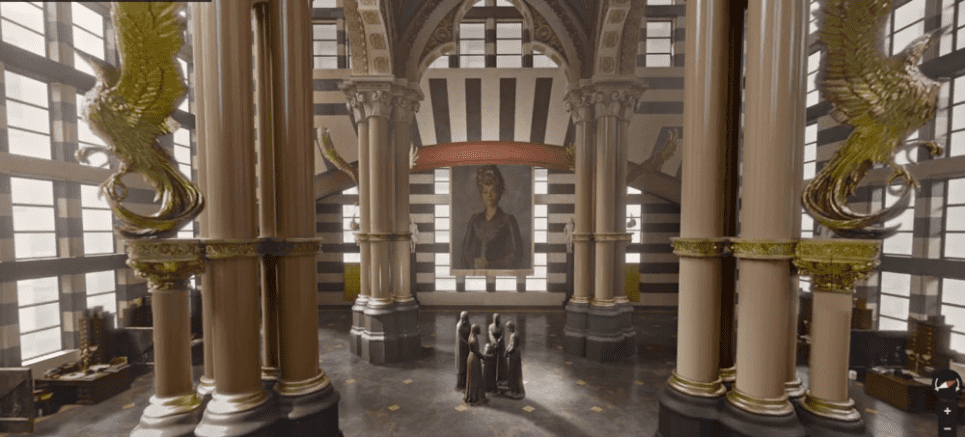
Now, of course, as muggles, for the most part, are not aware of the existence of magic, their governments and laws would not account for misuses of magic. The wizarding world has its own separate governments that work within the countries they reside in and apply their own laws and punishments for witches and wizards. In the USA, that’s MACUSA, but as this guide is primarily focused on magical law from the Harry Potter series, not the Fantastic Beasts and Where to Find Them franchise, we will not be looking at MACUSA in any detail.
Instead, we’ll focus on the UK’s magical government – the Ministry of Magic. The Minister of Magic will always make him or herself known to the muggle Prime Minister, as we see in a fascinating scene at the start of the book for Harry Potter and the Order of the Phoenix. This is so that the Prime Minister can be aware of magical goings-on and understand that sometimes the Ministry of Magic will need to take over a case that involves a witch or wizard, even if muggle police have been dealing with it.
There are many branches within the Ministry of Magic, each focusing on different aspects of magical law. The ministry itself is based in London, and the entrance is concealed by a magical phone booth from the streets. They can also flush themselves through a particular toilet. Floo powder is another viable means of entry and exit. Enforcers for the Ministry of Magic are known as Aurors, and they track down dark witches or wizards and bring them down. Harry Potter himself becomes an Auror for his career.
What Rules are There for Using Magic?
Without getting into the intricacies of specific laws, the ministry enforces a few broad rules. These essentially fall under the following 4 categories:
- You cannot use magic in the presence of a muggle. Muggles are not to be aware of witches and wizards’ existence, so you can’t use magic where they would be able to see.
- You can’t use magic outside of school if you’re under the age of 17. While students are encouraged to practice and learn spells within Hogwarts’ grounds, it’s forbidden to use it when not at school. Witches and wizards only get full autonomy over their magic when they hit the age of 17.
- You can’t use magic to hurt others. Much like muggles have laws forbidding hurting one another, it’s the same thing with magic. Magic is not to be wielded as a weapon, and if you use spells to attack another person, then you’re liable to be punished for it.
- You can’t use magic to create a dangerous object. Whilst many magical objects exist, witches and wizards need to be careful about what they’re creating. Dark magical objects are strictly prohibited, and you’re not allowed to own or make them.
There are also several more specific laws regarding a range of different applications for magic and dictating the limitations for interacting with magical beasts. However, the four rules above cover most of the more common breaches.
Magical Creatures
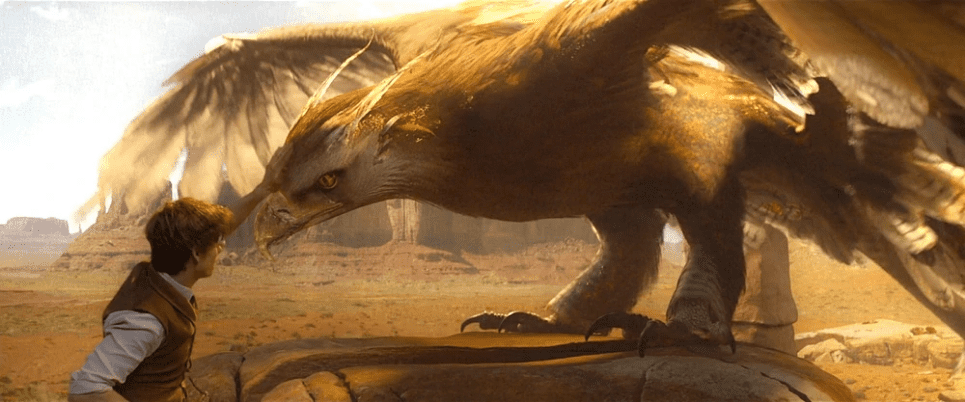
There are a whole host of magical creatures that crop up throughout the lore of Harry Potter. Some, such as dragons or mermaid, already exist in mainstream mythology. Others, such as kneazles and pygmy puffs, were invented by J.K Rowling for use in the series. This guide would end up being far too long if I tried to describe all the magical creatures that exist. Instead, I’d recommend you check out the book version of Fantastic Beasts and Where to Find Them. It’s entirely different to the film series. It is essentially a catalogue of all the creatures with full descriptions of each one. I have the illustrated version by Olivia Lomenech Gill. I’d highly recommend it, as it’s lovely to see her visual interpretations of each creature.
Magical creatures appear worldwide, often in areas populated by muggles, and there are dedicated branches of international wizarding governments whose job is to ensure the safety of muggles from these beasts. Some magical creatures such as puffskeins and kneazles are kept as pets by wizarding households. There are also often various uses for body parts or by-products of other magical creatures, such as unicorn hair or dragon blood. All magical creatures fall under one of the 5 following classifications:
- X. Boring. These are creatures deemed entirely uninteresting and not worthy of a witch or wizard’s time.
- XX. Harmless/ may be domesticated. These creatures are of no danger to anyone and could potentially make for great pets.
- XXX. Competent wizards should cope. These creatures could technically pose a danger, but it’s not a serious one. As long as a witch or wizard understood basic magic, they should be fine.
- XXXX. Dangerous/ requires specialist knowledge/ skilled wizards may handle. Although many of these creatures are dangerous, not all of them are. Some of them pose no threat but have unique conditions that make them hard to interact with, such as the demiguise, which is peaceful but incredibly hard to find.
- XXXXX. Known wizard killer/ impossible to train or domesticate. These are the most dangerous creatures, and all witches and wizards are advised to stay away. Few creatures fall under this category, and the ones that do are usually very rare. Interestingly, the basilisk comes under this category, but as we see in Harry Potter and the Chamber of Secrets, Tom Riddle is able to control one using parseltongue.
Magical Games and Sports
Having access to magic means witches and wizards can enjoy games and sports that muggles would not be able to play. Often, these games might be similar to muggle games but with a magical twist. One very popular game at Hogwarts is Gobstones, and there’re even several clubs for it. It’s essentially a game similar to how muggles play with marbles, where the goal is to capture your opponent’s marbles. However, every time a player loses a point, the stone is spelled to emit a foul-smelling liquid in the losing player’s face. Unsurprisingly, Gobstones did not have a very cool reputation, despite having a large playerbase.
A less smelly game that witches and wizards could play was wizard chess. The rules are identical to the muggle version of chess. Still, conveniently, players don’t actually have to move any pieces themselves. Instead, the pieces are semi-sentient and respond to verbal orders of where to go. The pieces may even sometimes give advice to the player or get sassy if their owner is playing badly. When it’s time to capture another piece, it can get pretty violent, with the capturing piece smashing the losing piece off the board. In Harry Potter and the Sorcerer’s Stone, a giant game of wizard chess is played as one of the obstacles keeping the sorcerer’s stone safe.
Quidditch
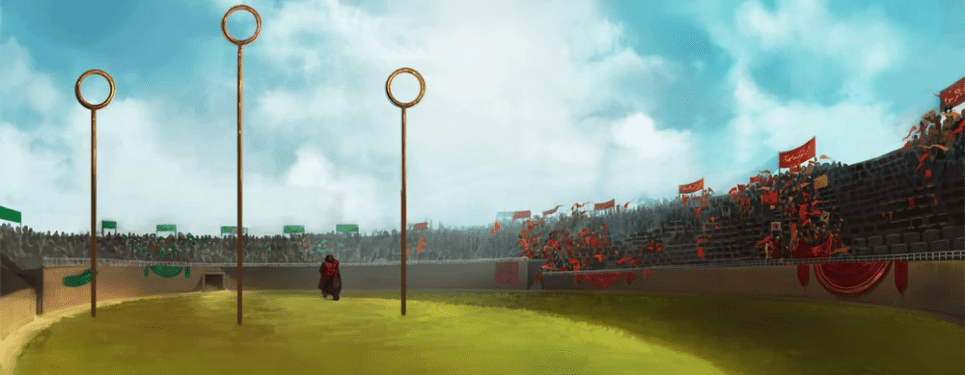
Arguably the most popular sport in the wizarding world is Quidditch. This is played on flying broomsticks and is internationally beloved. Each team has 7 players – 3 chasers, 2 beaters, a keeper, and a seeker. There are three goal posts at either end, and the goal is to throw the quaffle through one of the opposing team’s goalposts as many times as possible, scoring 10 points each time. However, the beaters use clubs to hit an aggressive ball called the bludger (of which there are two in each match), which will try and knock players off their brooms indiscriminately. It’s therefore also the job of beaters to protect their own teammates. Finally, a tiny ball known as the golden snitch will flit around the stadium. The seeker’s job is to catch the golden snitch, and when they do, their team is awarded 150 points, and the game ends.
Each of the 4 Hogwarts houses has their own Quidditch team, and a tournament is played over the course of the year, with the winning house earning the coveted Quidditch Cup. Harry Potter is the Gryffindor seeker throughout his time at Hogwarts, being chosen for the position in his very first year, a momentous achievement. Quidditch also has international tournaments, such as the Quidditch World Cup. In Harry Potter and the Goblet of Fire, Harry attends a match with the Weasleys to watch Ireland Vs Bulgaria. The event is shown to be very exciting and popular and enjoys a similar level of hype to something like the Super Bowl or World Cup in the muggle world.
Horcruxes
These are an example of dark magic and form the basis for Voldemort’s lore throughout the series. They are the reason he’s essentially immortal. Horcruxes are an item in which is trapped part of a witch or wizard’s soul. They can only be created through an act of pure evil, such as murder, and then the witch/ wizard has to split their own soul. In order to kill Voldemort, all the other horcruxes have to be destroyed first. Here are the 7 horcruxes and the means in which they were destroyed:
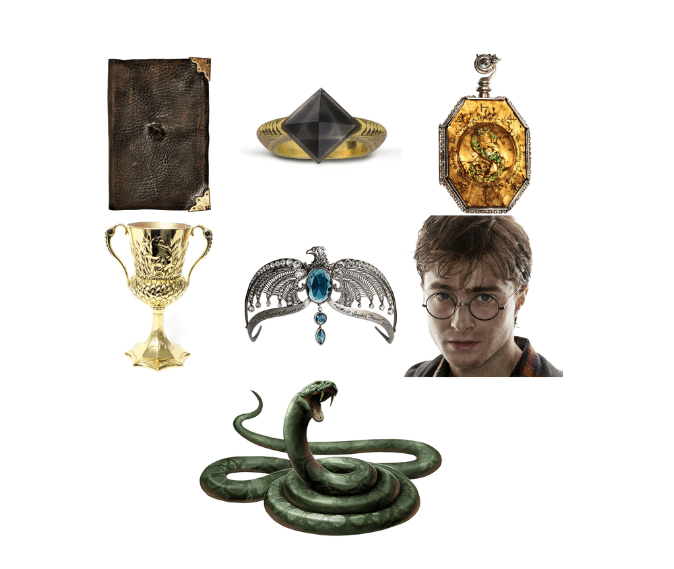
- Tom Riddle’s Diary. Destroyed by a basilisk fang.
- Marvolo Gaunt’s Ring. Destroyed with Godric Gryffindor’s Sword.
- Salazar Slytherin’s Locket. Destroyed with Godric Gryffindor’s Sword.
- Helga Hufflepuff’s Cup. Destroyed by a basilisk fang.
- Rowena Ravenclaw’s Diadem. Destroyed by Fiendfyre.
- Nagini. Destroyed with Godric Gryffindor’s Sword.
- Harry Potter. Destroyed by Voldemort himself using Avada Kedavra.
FAQs
Answer: The three most common wand cores are dragon heartstring, unicorn hair, and phoenix tail feather.
Answer: Voldemort is killed during a battle with Harry in Harry Potter and the Deathly Hallows after all his horcruxes were destroyed.
Answer: Whilst you obviously won’t be able to fly around on a real working broom, there are actually several clubs internationally where you can play a version of Quidditch that’s been modified for muggles. You run around with a broom between your legs, scoring points, and it has positions just like the actual game. Check online to see if there’s a Quidditch club in your local area!
Conclusion
As you can see, there’s a rich and detailed magic lore in Harry Potter. Hopefully, this guide has proven helpful to explaining it. Honestly, I’ve only touched the surface of what’s out there and reading the books/ watching the movies will help explain more about the world of the series. I’ve read/ watched Harry Potter more times than I could possibly count, having been a fan of the series for over two decades now, yet I still notice fascinating new things every time I dive back into that world. I’m sure it’ll be the same for you too!
